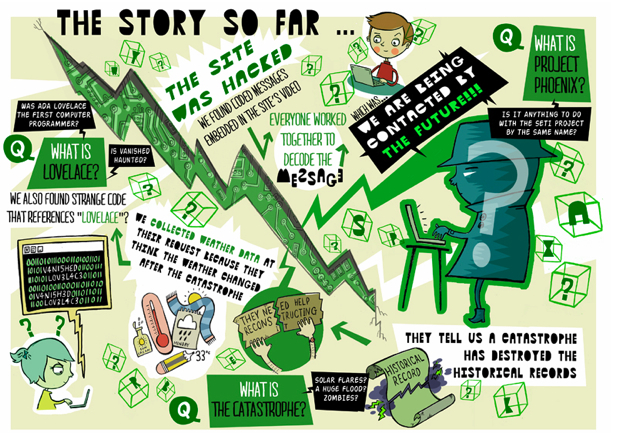Also see:




From DSC:
Immediately below is a presentation that I did for the Title II Conference at Calvin College back on August 11, 2011
It is aimed at K-12 audiences.
From DSC:
Immediately below is a presentation that I did today for the Calvin College Fall 2011 Conference.
It is aimed at higher education audiences.
Note from DSC:
There is a great deal of overlap here, as many of the same technologies are (or will be) hitting the K-12 and higher ed spaces at the same time. However, there are some differences in the two presentations and what I stressed depended upon my audience.
Pending time, I may put some audio to accompany these presentations so that folks can hear a bit more about what I was trying to relay within these two presentations.
Grading Moratorium: Steve Moore
From DSC:
I need to reflect on this idea further…but when dropout rates are hitting 20-30% for many parts of the country and when, for many students, school can often become a source of pain/discouragement rather than instilling a love for learning, I’m finding myself more open to ideas on how to change that situation. We need to foster a love for learning..and perhaps this type of thing would help.
How do we assess students’ learning without attaching the competitive — often discouraging/”I just can’t do this” — type of message? Are there better ways to tap into students’ passions, gifts, abilities, and creativity?
But how do you move forward with such an innovation, when there isn’t definitive proof that it will work? That is the key question educators and policymakers are grappling with.
Under the education priorities of President George W. Bush’s administration, the catchphrase “research base” was drilled into educators” heads when it came to new programs and initiatives. If it wasn’t research-based, it wasn’t worth adopting.
But technology innovations occur so rapidly that it’s often impossible to do scientifically based trials proving effectiveness before schools embrace new approaches. Think of social-networking tools, iPads, and e-readers. And what other new digital-learning tools might also emerge well before scientifically based research can justify their use in classrooms?
Also see:
From DSC:
From my 20+ years of experience with working with a variety of technologies, while there is an element of risk taking to implementing technologies, there are also enormous payoffs if organizations implement the appropriate technologies.
But how can we select and implement the most effective technologies? This is where we need to rely on our technologists out there and keep them growing in the knowledge of “the business”, not just the technologies. Tell them what you are trying to achieve, and they can greatly assist. No one can hit 100% — but good technologists can get you into the right game and into the right ballpark (if not exactly lining up the exact right players, which may change or take some tweaking).
NOTE:
Don’t rely on technologists who only see their jobs as keeping the systems running. Though we need technologists who keep the infrastructures up and running, at this juncture what organizations really need are visionaries who are knowledgeable about the needs of the business (as well as the technologies), and those who are willing to explore, experiment, and take some risks…i.e. to lead….to be instrumental in forming strategies and visions. The areas outside IT need to be aware of how critical technologies are becoming in their core strategies and plans. It’s not the same ball-game as it was. Those who use technologies strategically will survive and thrive.
It should be noted that there have been risks inherent in maintaining the status quo — a 20%-30% dropout rate (in K-12) across the United States is pretty risky too, at least in my mind.
From DSC:
What a great way to engage, inspire, involve students in music!
See:
Also see:
Next-Gen Classrooms: Aces of Space — from CampusTechnology.com by Jennifer Demski
Four schools use cutting-edge design principles and technology to create next-gen learning spaces, with a focus on collaboration and student engagement.
From DSC:
I originally saw this at:
Excerpt:
Of course, the future belongs to the young. You get a decent look at it ahead of time, though, by watching how they build new ways seize it.
Earlier today a 17 year old named Priyanka Jain launched a student run nonprofit called iCAREweCARE, which is dedicated to helping high school and college students identify causes they care about, find local organizations that address those problems, and then write about their experiences, or connect with their friends over them. There is a Web site, and Facebook connections for rapid and deep information sharing.
The cause-centered orientation is praiseworthy. The implications of this kind of social platform, however, could be what proves really world-changing
Excerpt from introduction (emphasis DSC):
Three factors are driving this new interest and enthusiasm for digital learning by educators. First, teachers and administrators are increasingly become technology-enabled themselves, using emerging technologies such as mobile devices, online classes and digital content to improve their own productivity. This development of a personal value proposition with the technology is propelling educators to think creatively about how to leverage these same tools in the classroom. Second, students and increasingly parents are demanding a different kind of learning experience and that is forcing even the most reluctant teachers and administrators to re-evaluate their perspectives about the value of technology within learning. As noted in prior Speak Up national reports, students have a very clear vision for 21st century learning. Their preference is for learning environments that are socially-based, un-tethered and digitally rich. Parents are also supportive of this new learning paradigm and as we noted in our first Speak Up 2010 report (released in April 2011) the emergence of a new trend of parental digital choice is an indication of this unprecedented support level. And schools and districts are waking up to this new trend. Concerns about parents’ capability to, for example, enroll their children in non-district provided online classes are compelling many districts to start virtual schools themselves. The third factor, the economy, and its resulting financial pressures on school and district budgets, has created a sense of urgency to more fully investigate how technologies can help educators meet their instructional goals with less expense.
All three factors converging at the same time has opened up a new window of possibilities for achieving the promise of technology to transform education. Evidence of this shift in perspective and vision by educators is noted in some comparative Speak Up findings over the past few years.
…
This report is the second in a two-part series to document the key national findings from Speak Up 2010.
…
In this companion report, “The New 3E’s of Education: Enabled, Engaged, Empowered – How Today’s Educators are Advancing a New Vision for Teaching and Learning,” we explore how teachers, principals, district administrators, librarians and technology coordinators are addressing the student vision for learning around three key trends. These trends have generated significant interest in the past year at conferences, in policy discussions and within our schools and districts: mobile learning, online and blended learning and digital content.
While each of these trends includes the essential components of the student vision of socially-based, un-tethered and digitally-rich learning, they also provide a unique backdrop for investigating the role of educators to engage, enable and empower students through the use of these emerging technologies.
• Role of Librarians and Technology Coordinators: To enable student use of the emerging technologies through their planning, support and recommendation responsibilities.
• Role of Classroom Teachers: To engage students in rich, compelling learning experiences through the effective use of these technologies in the classroom.
• Role of School and District Administrators: To empower both teachers and students to creatively envision the future of digital learning, and to provide opportunities for exploring the elements of a new shared vision for learning.
John Hunter on the World Peace Game — TED March 2011 — my thanks to Mr. Joseph and Mrs. Kate Byerwalter for this great presentation
About this talk
John Hunter puts all the problems of the world on a 4’x5′ plywood board — and lets his 4th-graders solve them. At TED2011, he explains how his World Peace Game engages schoolkids, and why the complex lessons it teaches — spontaneous, and always surprising — go further than classroom lectures can.
About John Hunter
Teacher and musician John Hunter is the inventor of the World Peace Game (and the star of the new doc “World Peace and Other 4th-Grade Achievements”).
MIT creates the one video game you’ll be thrilled to see your kid get hooked on — from FastCompany.com by David Zax
“The premise is that people living in the future have contacted us in the present, to answer a question: What event occurred between our time and theirs that led to the loss of civilization’s historical records? Students must decode clues in hidden messages, and in response find and provide information about Earth’s current condition, such as temperature and species data, to help people in the future deduce what wound up happening.”
Daniel Christian:
A Vision of Our Future Learning Ecosystems
In the near future, as the computer, the television, the telephone (and more) continues to converge, we will most likely enjoy even more powerful capabilities to conveniently create and share our content as well as participate in a global learning ecosystem — whether that be from within our homes and/or from within our schools, colleges, universities and businesses throughout the world.
We will be teachers and students at the same time — even within the same hour — with online-based learning exchanges taking place all over the virtual and physical world. Subject Matter Experts (SME’s) — in the form of online-based tutors, instructors, teachers, and professors — will be available on demand. Even more powerful/accurate/helpful learning engines will be involved behind the scenes in delivering up personalized, customized learning — available 24x7x365. Cloud-based learner profiles may enter the equation as well.
The chances for creativity, innovation, and entrepreneurship that are coming will be mind-blowing! What employers will be looking for — and where they can look for it — may change as well.
What we know today as the “television” will most likely play a significant role in this learning ecosystem of the future. But it won’t be like the TV we’ve come to know. It will be much more interactive and will be aware of who is using it — and what that person is interested in learning about. Technologies/applications like Apple’s AirPlay will become more standard, allowing a person to move from device to device without missing a beat. Transmedia storytellers will thrive in this environment!
Much of the professionally done content will be created by teams of specialists, including the publishers of educational content, and the in-house teams of specialists within colleges, universities, and corporations around the globe. Perhaps consortiums of colleges/universities will each contribute some of the content — more readily accepting previous coursework that was delivered via their consortium’s membership.
An additional thought regarding higher education and K-12 and their Smart Classrooms/Spaces:
For input devices…
The “chalkboards” of the future may be transparent, or they may be on top of a drawing board-sized table or they may be tablet-based. But whatever form they take and whatever is displayed upon them, the ability to annotate will be there; with the resulting graphics saved and instantly distributed. (Eventually, we may get to voice-controlled Smart Classrooms, but we have a ways to go in that area…)
Below are some of the graphics that capture a bit of what I’m seeing in my mind…and in our futures.
Alternatively available as a PowerPoint Presentation (audio forthcoming in a future version)

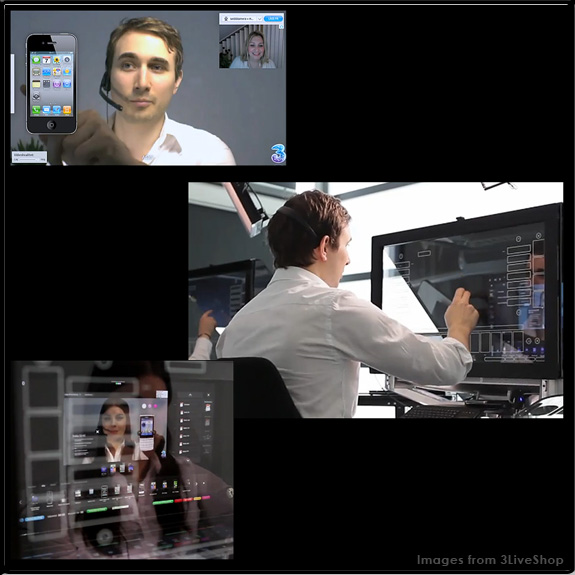
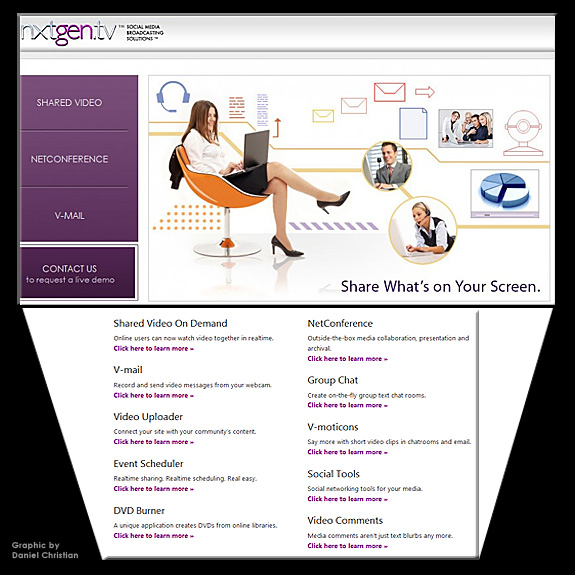


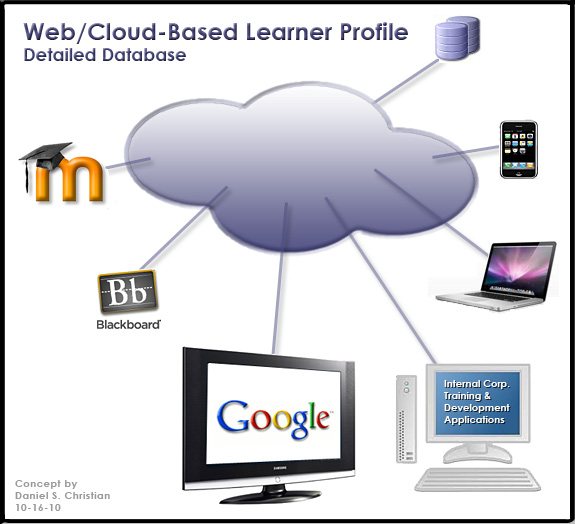
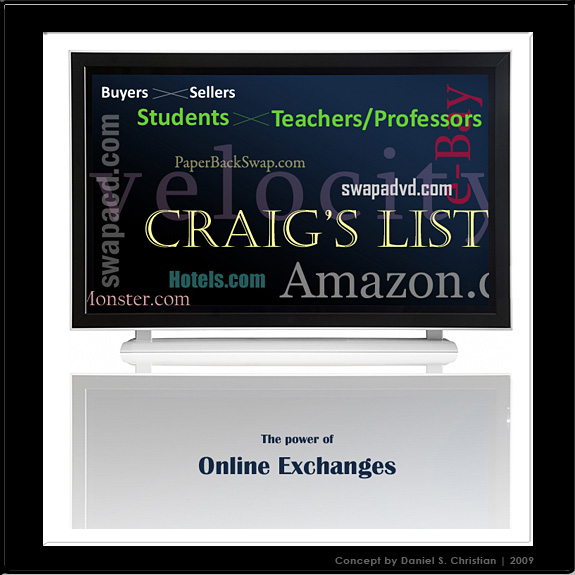
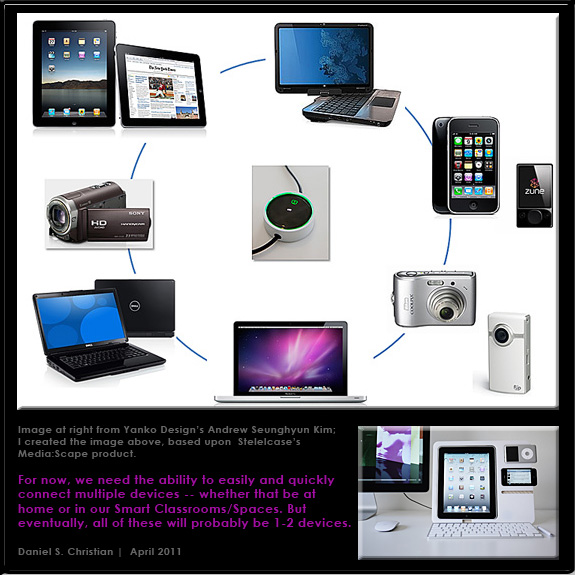
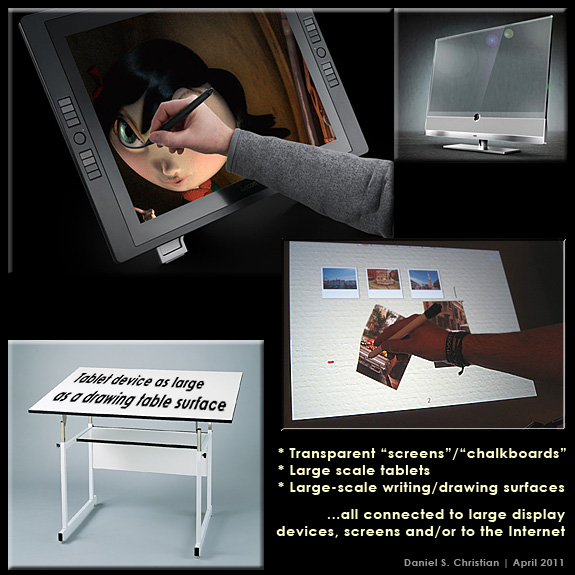

— from Daniel S. Christian | April 2011
Addendum on 4-14-11:
Some presentations:
From DSC:
A couple of my take-aways from Will’s presentation:
We need life prep, not test prep.
We need a “different” system vs striving to make the current system “better”.
Also see:
Also see the TEDxNYED Speaker Lineup:
Also see:
If you want to truly engage students, give up the reins — from Ewan McIntosh
During the final half of 2010, I asked more than 1,500 teachers around the globe two questions: what are your happiest memories from learning at school, and what are your least happy experiences?
When I do the “reveal” of what I think their answers will be, every workshop has a “but how did he know?” reaction. It’s more akin to an audience’s response to illusionist Derren Brown than to the beginning of a day of professional development.
For teachers’ answers are always the same. At the top is “making stuff”, then school trips, “feeling I’m making a contribution” and “following my own ideas”. Their least happy experiences are “a frustration at not understanding things”, “not having any help on hand” and “being bored”, mostly by “dull presentations”. “Not seeing why we had to do certain tasks” appeared in every continent.
Most of these educators agreed that the positive experiences they loved about school were too few, and were outnumbered by the “important but dull” parts of today’s schooling: delivering content, preparing for and doing exams.
But while a third of teachers generally remember “making stuff” as their most memorable and happy experience at school, we see few curricula where “making stuff” and letting students “follow their own ideas” makes up at least a third of the planned activity.
